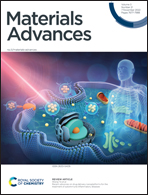Lanthanoid coordination compounds as diverse self-templating agents towards hierarchically porous Fe–N–C electrocatalysts†
Abstract
Pore structure is a critical material property of carbon materials, determining their surface area, active site accessibility, wettability, and efficiency of bubble removal. In the self-templating approach to pore design, inorganic particles form inside a carbon during pyrolysis, templating meso- and macropores. This strategy is simple and economic, yet limited by choice of templating elements and by incomplete understanding of carbon-template interactions. We followed the self-templating process of eight lanthanoid coordination compounds (the iminodiacetates of La3+, Nd3+, Sm3+, Eu3+, Gd3+, Tb3+, Er3+, and Yb3+), shedding light on the pore structure and the processes that form it. The resulting carbons showed high BET specific surface areas (up to 2700 m2 g−1), hierarchical micro-, meso- and macro-porosity, and lanthanoid-imprinted nitrogen moieties that could be transmetalated to yield atomically dispersed Fe–Nx sites. Some of the resulting Fe–N–C materials showed excellent activity towards hydrazine oxidation electrocatalysis, helping to identify several key links between porosity and electrocatalysis, especially the removal of electrode-blocking N2(g) bubbles. Overall, this detailed investigation expands the toolbox of rational design methods towards rich and useful electrocatalyst porosities.



 Please wait while we load your content...
Please wait while we load your content...